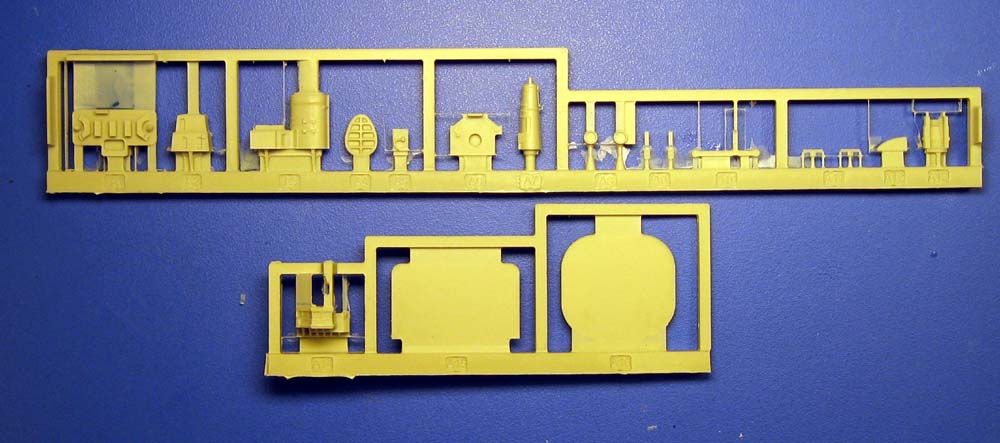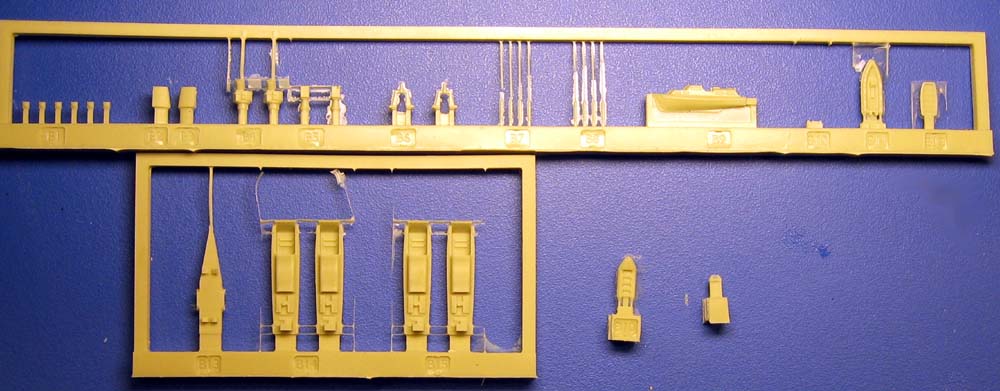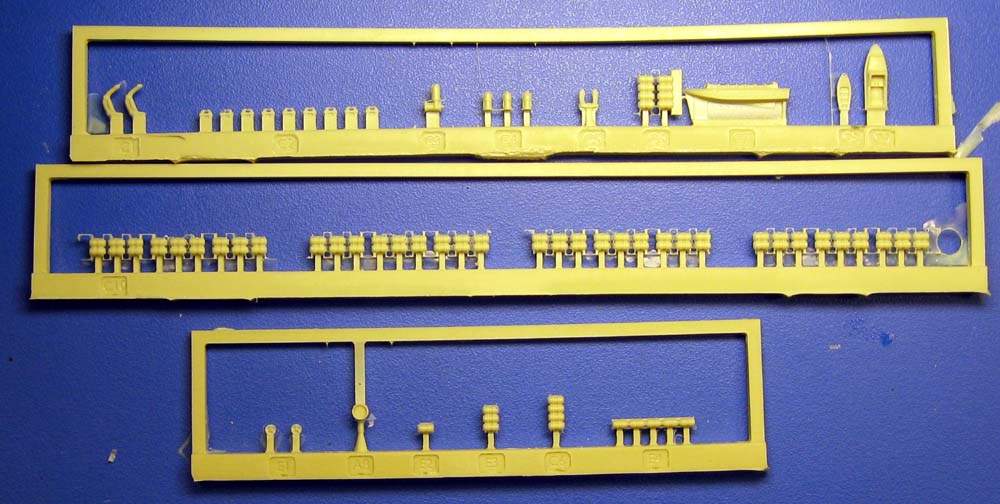HMS Hermes R12

Reviewed by Sean Hert
November 2012

| HISTORY | |||||||||||||||||||||||||||||
|
HMS Hermes was originally laid down as HMS Elephant, a Centaur class Light Fleet Carrier, in 1944. As World War II drew to a close, construction was halted on the four ships laid down, and cancelled for the planned other four. After many fits and starts, HMS Hermes was finally commissioned in 1959, 15 years after construction began. She was completed with an angled flight deck, steam catapults and arresting gear- but her small size as a light fleet carrier precluded her from operating many the latest jet aircraft which had evolved in the 15 years since she was started. In the early 1970's, Hermes was converted into a "Commando Carrier", where her catapults and arresting gear were removed and her facilities expanded to house a complete Marine Commando with the organic helicopter support. This short-lived version was quickly converted to all-ASW, and then in 1981 her flight deck was strengthened and a 12° ski-jump was added, converting Hermes to a VTOL carrier. It was in this configuration Hermes sailed for the Falkland Islands as flagship of the Royal Navy forces in 1982, equipped with 12 Fleet Air Arm FRS.1 Sea Harriers and 18 various Sea Kings. During the conflict, her air group underwent various changes, including Royal Air Force GR.3 Harriers, and Lynx helicopters. After the successful recovery of the Falkland Islands, Hermes returned to England to refit. She was sold to the Indian Navy in 1986, and was renamed INS Viraat. INS Viraat has undergone various refits in the 25 years since, and is still in service today. Orange Hobby has release a resin 1/700 HMS Hermes R12 in a Falklands War fit. This waterline kit is comprised of resin hull and parts, six frets of photoetch, a decal sheet and two brass domed antennas. |
|||||||||||||||||||||||||||||
| HULL | |||||||||||||||||||||||||||||
|
Hermes comes in a waterline only configuration, with Orange Hobby's signature pour stubs and hollow-cast hull. The flightdeck is molded in place, offering a good rigid hull with plenty of great detail. The hull has only minor blemishes which can be easily sanded out or trimmed. The flightdeck has a regular series of holes molded in place, which continue up most of the ski-jump as well. The holes are not fully molded in some places, and some even have tiny fingers of silicone stuck in them; the silicone will require a removal before painting, and some may wish to re-drill the missing holes to complete the deck pattern. There is also a very slight "wave" in the shape of flight deck edge of the review kit, starboard side, near the island. It looks like it was caused during the de-mold process, and not an issue with the master. The galleries which surround the flightdeck are all well detailed, with most details molded in place- pipe, catwalks and ladders, etc. The underside of the angled flight deck is also well detailed, and will take weathering very well. |
|||||||||||||||||||||||||||||
 |
|||||||||||||||||||||||||||||
|
|||||||||||||||||||||||||||||
|
The other primary assembly of Hermes is the island which fits into a recess on the flightdeck. It is molded as one piece, and exhibits the same high level of detail seen on the hull- a level of detail Orange Hobby is becoming well known for. |
|||||||||||||||||||||||||||||
|
|||||||||||||||||||||||||||||
| RESIN PARTS | |||||||||||||||||||||||||||||
|
The rest of the resin parts come attached to sprues, about 13 in total. The "A" sprues have most of the remaining large parts, like those needed to complete the island, and the two aircraft hangar elevators. The island subassemblies consist of a side sponson for the bridge, which appears just as detailed as the rest of the island. A funnel stack, with cap and a tower for fitting the large Type 965 radar. |
|||||||||||||||||||||||||||||
 |
|||||||||||||||||||||||||||||
|
|||||||||||||||||||||||||||||
|
B has SeaCat launchers, missiles and directors, along with RHIB's, LCVP's and a motor pinnace. There is also a trailer for the pinnace- this boat was usually stowed near the island, on the flight deck. |
|||||||||||||||||||||||||||||
 |
|||||||||||||||||||||||||||||
|
|||||||||||||||||||||||||||||
|
Sprues C have a large selection of life raft canisters, along with more ship's boats, gravity davits, and some chocks. |
|||||||||||||||||||||||||||||
 |
|||||||||||||||||||||||||||||
|
|||||||||||||||||||||||||||||
| AIRCRAFT | |||||||||||||||||||||||||||||
|
This Hermes kit includes 2 FRS.1 Sea Harriers. Each aircraft is made up of both resin and photoetched parts. The aircraft fuselage and wings are molded in resin, while the tail surfaces, yaw sensor, wing pylons, and extended gear are in etched brass. The etch also includes six towbars to model with your Harrier. It is interesting to note the photoetch includes six tow bars, but four yaw sensors, four sets of gear, and enough tail and pylon parts for eight Harriers. |
|||||||||||||||||||||||||||||
|
|||||||||||||||||||||||||||||
|
The two included helicopters in this kit have been labeled by Orange Hobby as "WS-61's", the British-built version of the Sikorsky SH-3 Sea King, they are probably more accurately described as "HAS.5's". Like the Sea Harriers, these helos are built from both resin and photoetch components. The fuselage and landing gear sponsons are in resin. The boom and tail assembly are attached, but need to be separated- the tail can then be modeled either deployed or folded/stowed. There is a cavity molded in place for both the cockpit and cabin areas, to give the perception of an interior when built- another great characteristic of Orange Hobby helos. The etch includes the five-bladed rotors in both stowed and deployed arrangements, tail rotor and stabilizer, as well cabin and cockpit doors. | |||||||||||||||||||||||||||||
|
|||||||||||||||||||||||||||||
| PHOTOETCH | |||||||||||||||||||||||||||||
|
Hermes has four sheets of photoetch to detail the ship. There is a large variety of parts included on these sheets to add to the already detailed resin hull. Sheet A has many lengths of railing, many are pre-fitted in length, the boom for the ship's crane, island-mounted lights for the flight deck. Also included are parts to make up the girders which support the underside of the deck-edge elevator and the Type 965 radar. Rounding out this sheet are a number of watertight doors, which include fine frames, and are suitable to positioned open or closed. |
|||||||||||||||||||||||||||||
|
|||||||||||||||||||||||||||||
|
B has more railings, catwalks and ladders, as well as a large mainmast assembly and details for the various boats on Hermes. |
|||||||||||||||||||||||||||||
|
|||||||||||||||||||||||||||||
|
C is mostly focused on the liferaft cannister boxes with some remaining details filling out the sheet; antennas, small platforms and railings, etc. |
|||||||||||||||||||||||||||||
|
|||||||||||||||||||||||||||||
|
|||||||||||||||||||||||||||||
| DECAL | |||||||||||||||||||||||||||||
|
Hermes includes a single, long sheet of decals. This sheet consists mostly of flight deck markings, with pennant numbers for the island and a number of tiny roundels for the aircraft. Not included are any of the dry transfers seen on earlier Orange Hobby kits. |
|||||||||||||||||||||||||||||
 |
|||||||||||||||||||||||||||||
|
|||||||||||||||||||||||||||||
| INSTRUCTIONS | |||||||||||||||||||||||||||||
|
There are eight pages of instructions on four double-sided pages. The steps appear easy to follow, but they are not numbered. The pages can get a bit "busy"; meaning, there are many arrows and indicators swirling around each page, so plan assembly sequences accordingly. The last two pages have line drawings to aid in the painting and application of decals and transfers. |
|||||||||||||||||||||||||||||
|
|||||||||||||||||||||||||||||
| CONCLUSIONS | |||||||||||||||||||||||||||||

It is well past time this carrier was made available. A neat little kit, it just needs more aircraft! Orange Hobby continues to impress with one successful release after another, and all are very competitively priced. Highly recommended! This kit of the 1/700 HMS Hermes R12, produced by Orange Hobby, is item number N07-006-480, priced around $85.00USD. See the whole line on their website! |
|||||||||||||||||||||||||||||